
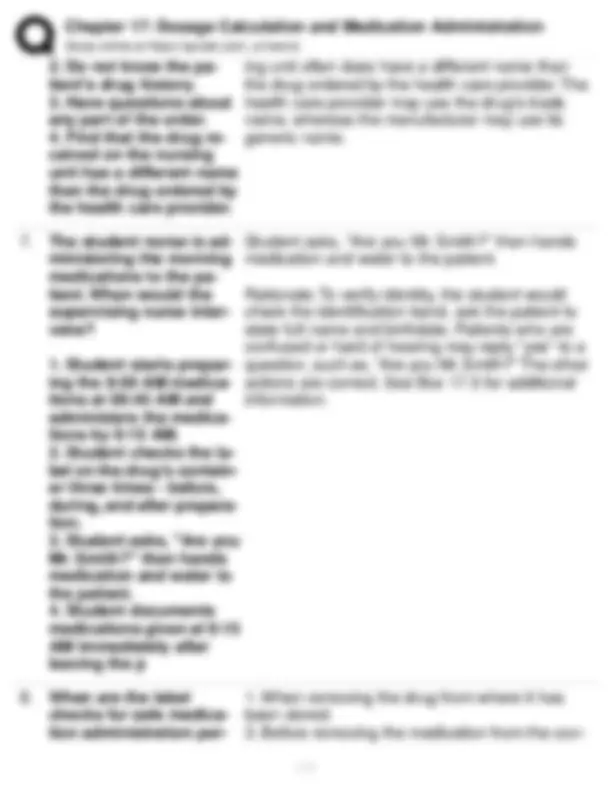
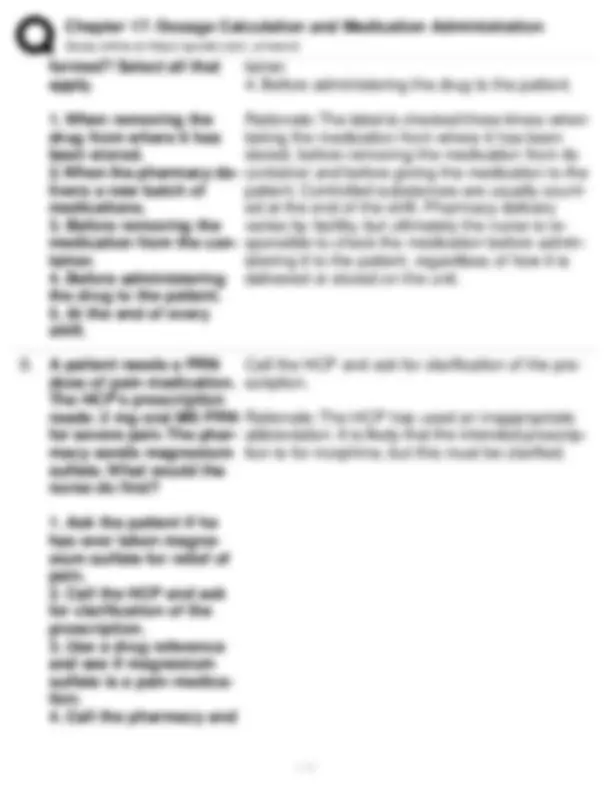
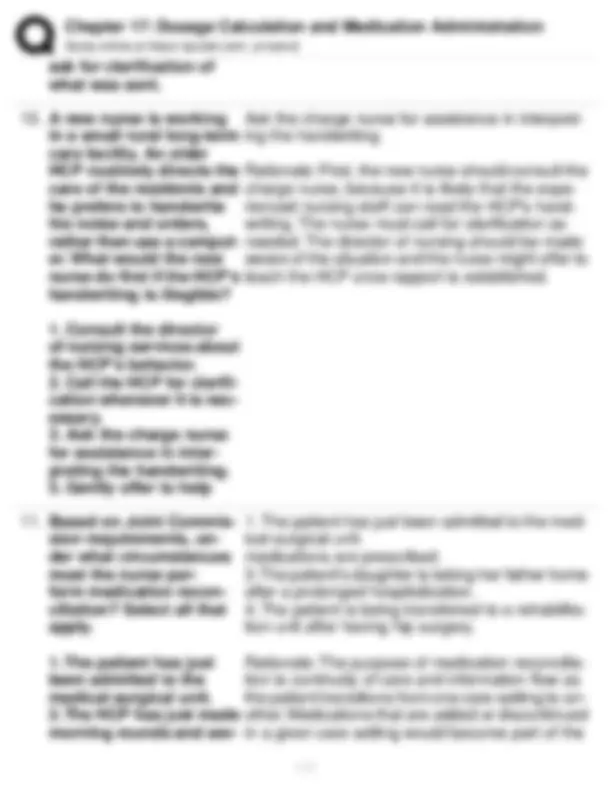
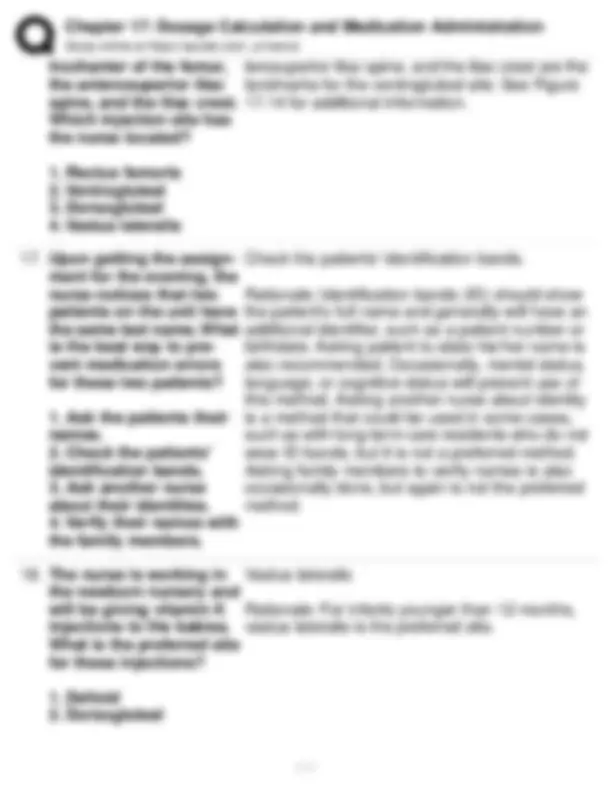
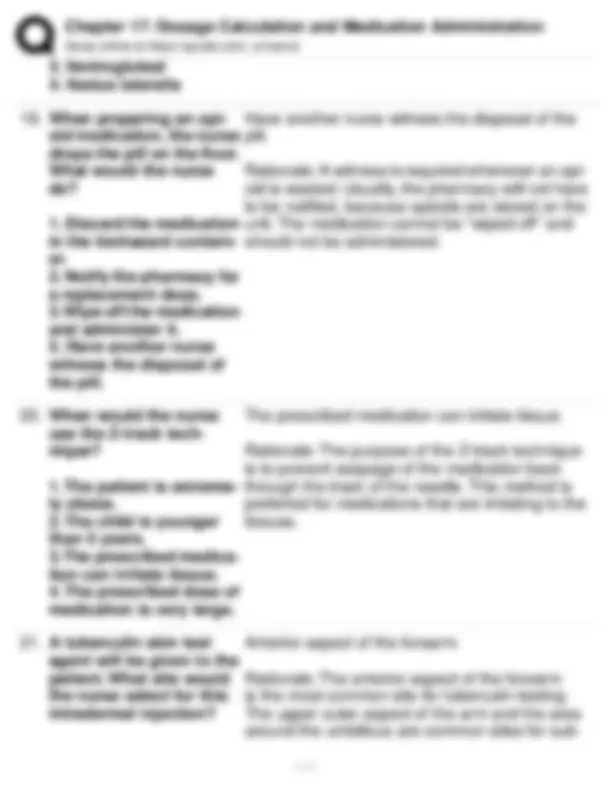
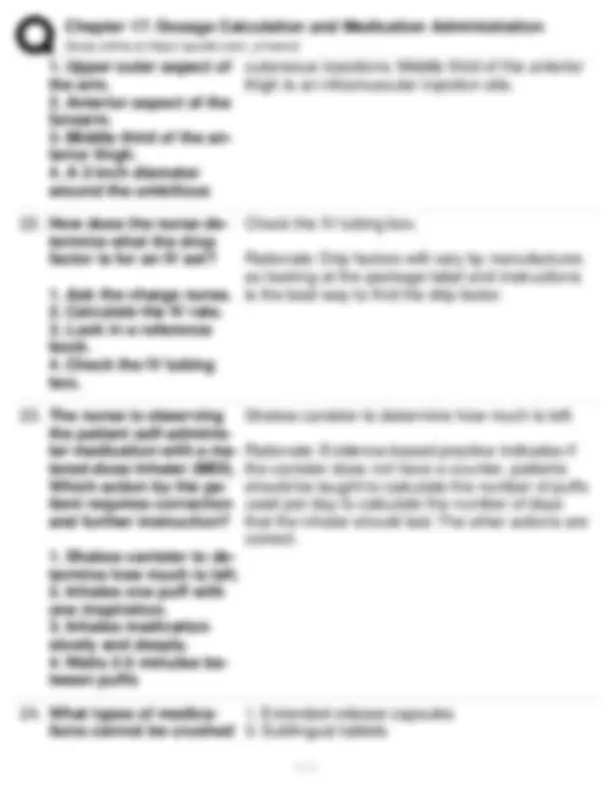
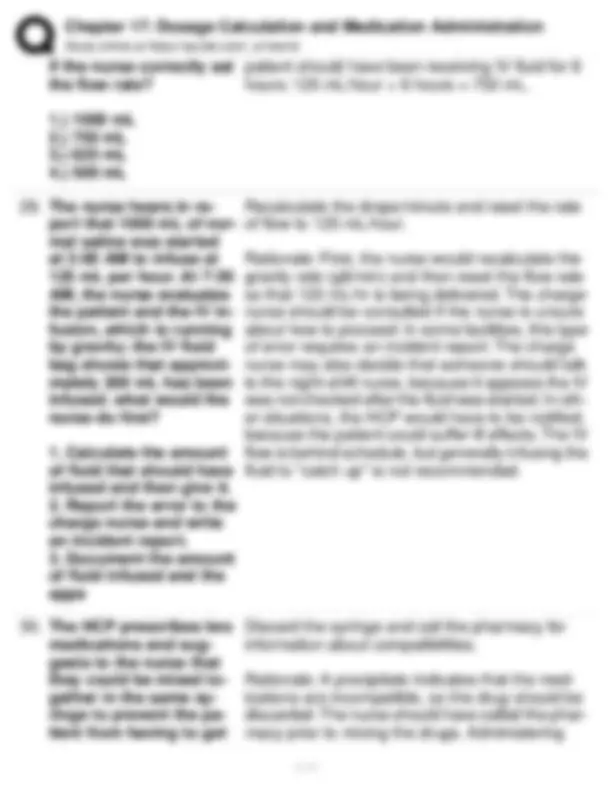
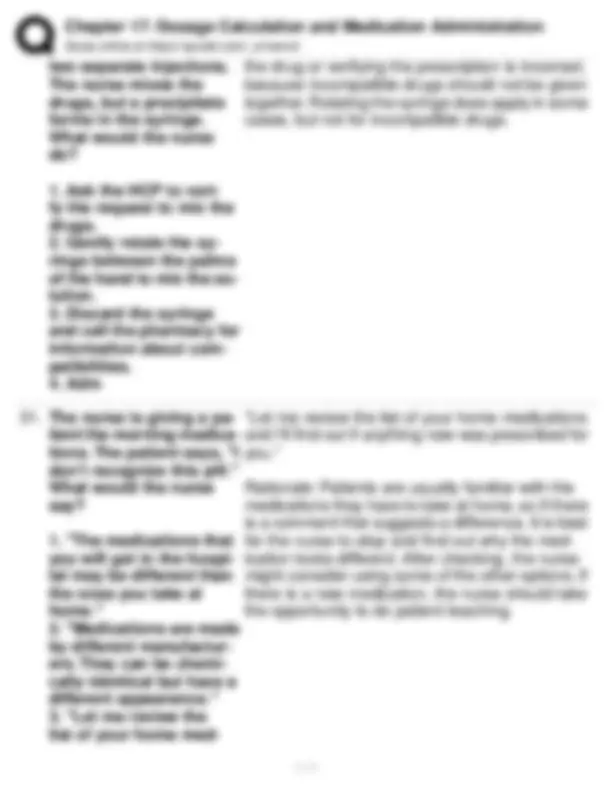
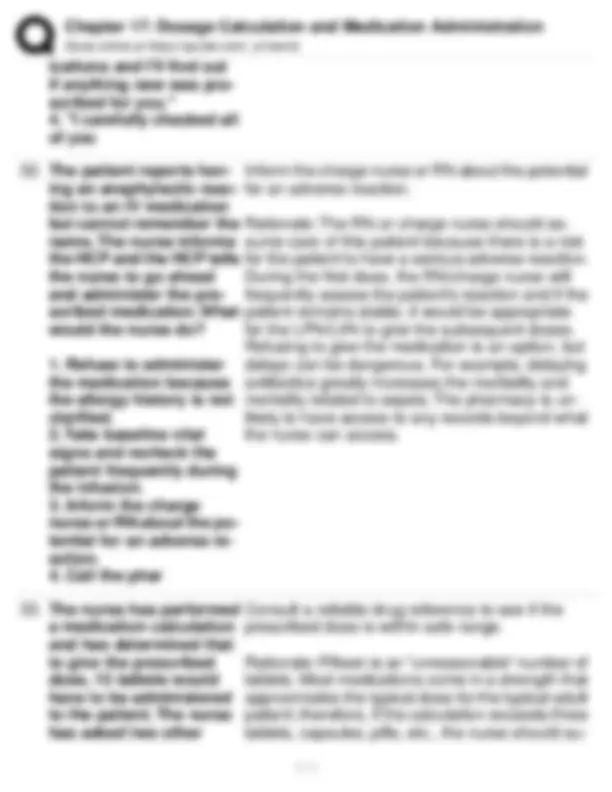
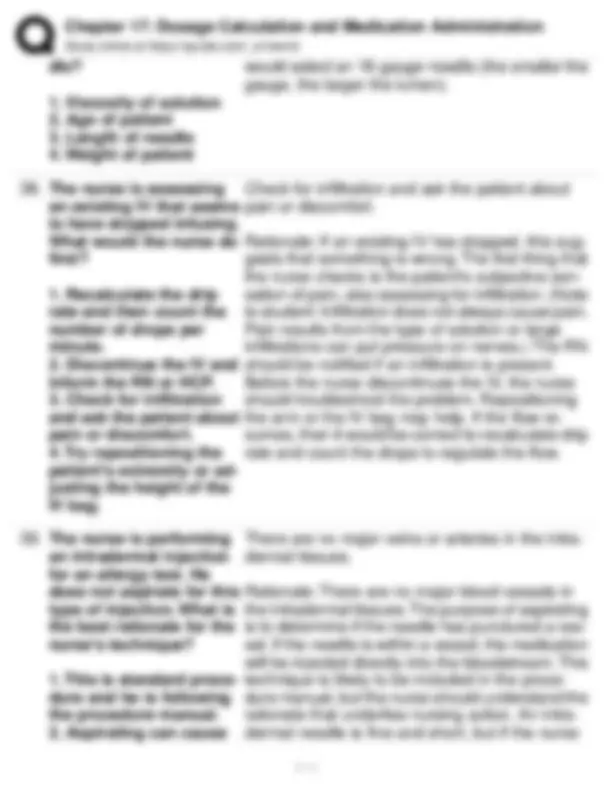
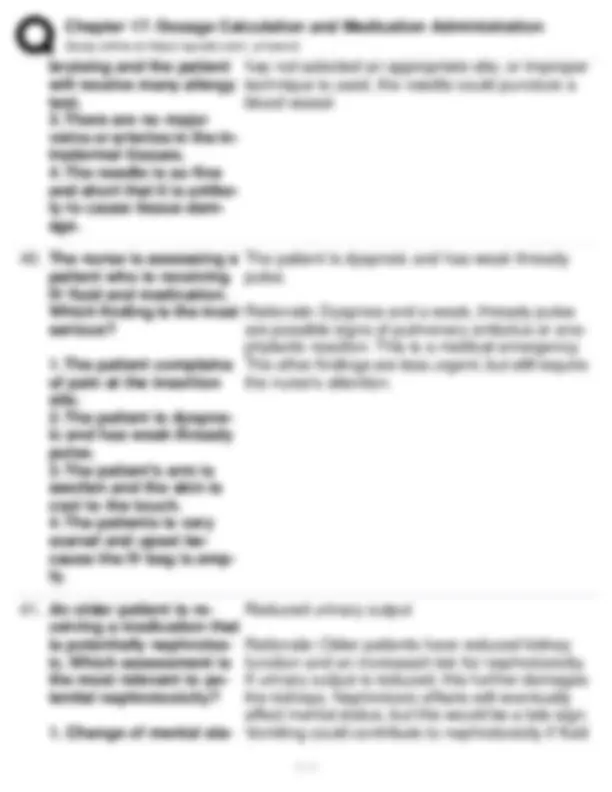
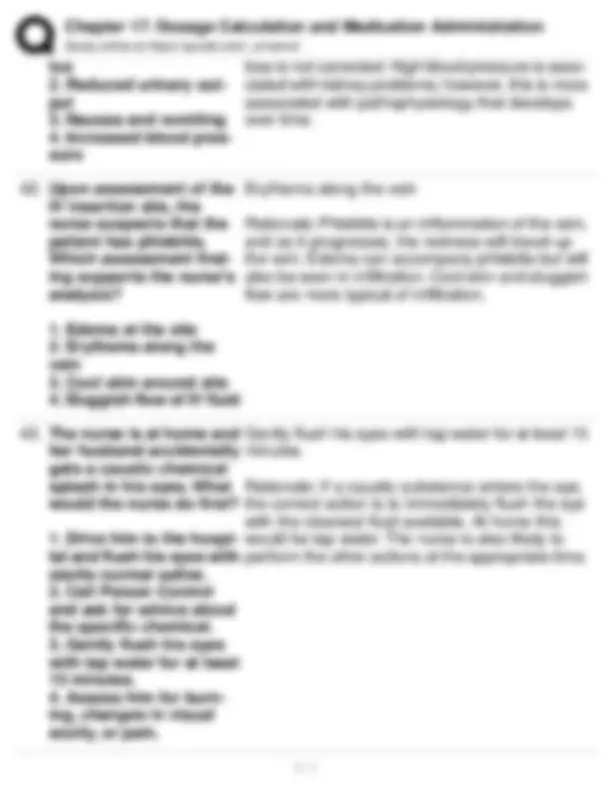
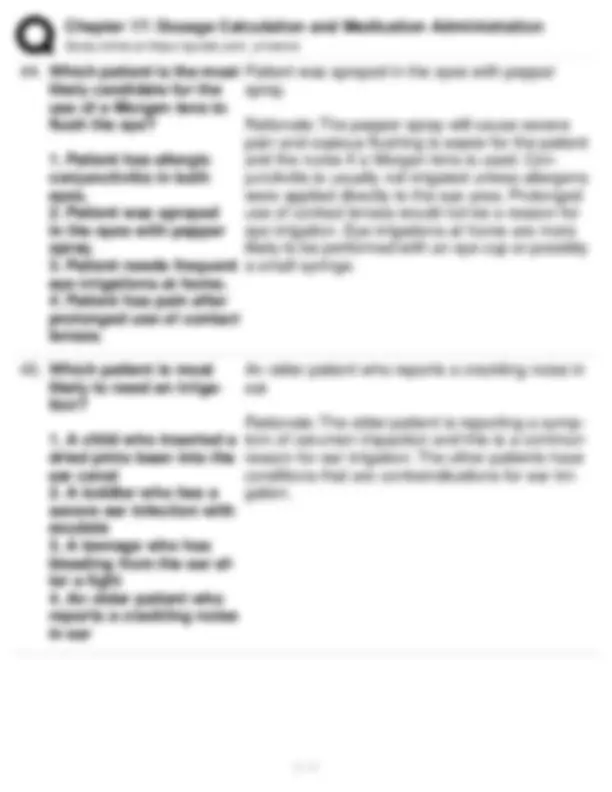


Study with the several resources on Docsity

Earn points by helping other students or get them with a premium plan


Prepare for your exams
Study with the several resources on Docsity

Earn points to download
Earn points by helping other students or get them with a premium plan
Community
Ask the community for help and clear up your study doubts
Discover the best universities in your country according to Docsity users
Free resources
Download our free guides on studying techniques, anxiety management strategies, and thesis advice from Docsity tutors
A series of exercises and questions related to dosage calculation and medication administration. It covers various aspects of medication administration, including drug interactions, injection techniques, dosage conversions, and medication reconciliation. Rationales for each question, explaining the correct answers and highlighting important concepts in medication safety.
Typology: Exams
1 / 21

This page cannot be seen from the preview
Don't miss anything!














Study online at https://quizlet.com/_e1wwnd
What is the term for when one drug increases the action or the effect of an- other drug?
Interaction
Antagonist
Synergism
Incompatibility Synergism Rationale: When one drug increases the action or effects of another drug, it is called potentiation or synergism. Drug interaction is when the com- bined actions of two or more drugs given together produce a totally different than expected effect. A drug that will block the action of another drug is an antagonist. Drug incompatibility is when a drug does not combine chemically with another drug
When preparing a med- ication for a subcuta- neous injection, what size needle length is needed? 1.) 1½ to 2 in 2.) 1 to 1½ in 3.) ½ to ] in 4.) \ to ] in ½ to ] in Rationale: Needle length for subcutaneous injec- tions is usually ½ to ] in. Intramuscular injections may require a 1- to 1½-in needle. A - to ]-in needle is used for intradermal injections.
The health care provider orders Dilantin (pheny- toin) 0.2 g PO twice daily. The label on the medication reads Dilan- tin 100 mg per capsule. How many capsule(s) will you prepare to adminis- ter one dose? 1.) 1 capsule 2.) 2 capsules 3.) 3 capsules 4.) 4 capsules 2 capsules Rationale: You would need to convert the 0.2 g to mg = 200 mg. To figure the amount, you would take the desired amount (200 mg), divide it by the amount you have (100 mg), and multiply by the capsule (1 capsule). Thus 1 dose equals 2 capsules.
The health care provider orders that a patient 0.2 mL
Study online at https://quizlet.com/_e1wwnd receive cyanocobalamin (vitamin B12) 100 mcg IM every month. The vial reads: cyanocobalamin (vitamin B12) 0.5 mg/ mL. How many milliliters will you administer to the patient? 1.) 0.2 mL 2.) 0.5 mL 3.) 1 mL 4.) 2 mL Rationale: 1. Convert 100 mcg to mg = 0.1 mg. Formula is: desired amount (0.1 mg) divided by amount on hand (0.5 mg) then multiplied by mL (1 mL). The amount to be given is 0.2 mL.
The health care provider orders 3000 mL of 5% dextrose to be adminis- tered over 24 hours. How many milliliters per hour will be administered? 1.) 50 mL 2.) 75 mL 3.) 100 mL 4.) 125 mL 125 mL Rationale: To determine how many milliliters per hour are to be administered, divide the total amount prescribed by the total time period. For- mula: 3000 mL divided by 24 hours = 125 mL/h.
The nurse is preparing to administer 8 a.m. med- ications to assigned pa- tients. The nurse reads and reviews all medica- tion orders. What would prevent the nurse from administering a medica- tion? (Select all that ap- ply.)
The nurse did not write the order.
Study online at https://quizlet.com/_e1wwnd formed? Select all that apply.
Study online at https://quizlet.com/_e1wwnd ask for clarification of what was sent.
A new nurse is working in a small rural long-term care facility. An older HCP routinely directs the care of the residents and he prefers to handwrite his notes and orders, rather than use a comput- er. What would the new nurse do first if the HCP's handwriting is illegible?
Consult the director of nursing services about the HCP's behavior.
Call the HCP for clarifi- cation whenever it is nec- essary.
Ask the charge nurse for assistance in inter- preting the handwriting.
Gently offer to help Ask the charge nurse for assistance in interpret- ing the handwriting. Rationale: First, the new nurse should consult the charge nurse, because it is likely that the expe- rienced nursing staff can read the HCP's hand- writing. The nurse must call for clarification as needed. The director of nursing should be made aware of the situation and the nurse might offer to teach the HCP once rapport is established.
Based on Joint Commis- sion requirements, un- der what circumstances must the nurse per- form medication recon- ciliation? Select all that apply.
The patient has just been admitted to the medical-surgical unit.
The HCP has just made morning rounds and sev-
The patient has just been admitted to the med- ical-surgical unit. medications are prescribed.
The patient's daughter is taking her father home after a prolonged hospitalization.
The patient is being transferred to a rehabilita- tion unit after having hip surgery. Rationale: The purpose of medication reconcilia- tion is continuity of care and information flow as the patient transitions from one care setting to an- other. Medications that are added or discontinued in a given care setting would become part of the
Study online at https://quizlet.com/_e1wwnd HCP wrote for several pa- tients. Which one will the nurse attend to first?
Study online at https://quizlet.com/_e1wwnd trochanter of the femur, the anterosuperior iliac spine, and the iliac crest. Which injection site has the nurse located?
Study online at https://quizlet.com/_e1wwnd
Study online at https://quizlet.com/_e1wwnd for ease of administra- tion? Select all that apply.
Study online at https://quizlet.com/_e1wwnd if the nurse correctly set the flow rate? 1.) 1000 mL 2.) 750 mL 3.) 625 mL 4.) 500 mL patient should have been receiving IV fluid for 6 hours: 125 mL/hour × 6 hours = 750 mL.
The nurse hears in re- port that 1000 mL of nor- mal saline was started at 3:00 AM to infuse at 125 mL per hour. At 7: AM, the nurse evaluates the patient and the IV in- fusion, which is running by gravity; the IV fluid bag shows that approxi- mately 200 mL has been infused. what would the nurse do first?
Calculate the amount of fluid that should have infused and then give it.
Report the error to the charge nurse and write an incident report.
Document the amount of fluid infused and the appe Recalculate the drops/minute and reset the rate of flow to 125 mL/hour. Rationale: First, the nurse would recalculate the gravity rate (gtt/min) and then reset the flow rate so that 125 mL/hr is being delivered. The charge nurse should be consulted if the nurse is unsure about how to proceed. In some facilities, this type of error requires an incident report. The charge nurse may also decide that someone should talk to the night-shift nurse, because it appears the IV was not checked after the fluid was started. In oth- er situations, the HCP would have to be notified, because the patient could suffer ill effects. The IV flow is behind schedule, but generally infusing the fluid to "catch up" is not recommended.
The HCP prescribes two medications and sug- gests to the nurse that they could be mixed to- gether in the same sy- ringe to prevent the pa- tient from having to get Discard the syringe and call the pharmacy for information about compatibilities. Rationale: A precipitate indicates that the med- ications are incompatible, so the drug should be discarded. The nurse should have called the phar- macy prior to mixing the drugs. Administering
Study online at https://quizlet.com/_e1wwnd two separate injections. The nurse mixes the drugs, but a precipitate forms in the syringe. What would the nurse do?
Study online at https://quizlet.com/_e1wwnd nurses to recheck the cal- culations and the answer is always 15. What would the nurse do first?
Study online at https://quizlet.com/_e1wwnd
Study online at https://quizlet.com/_e1wwnd bruising and the patient will receive many allergy test.
Study online at https://quizlet.com/_e1wwnd tus